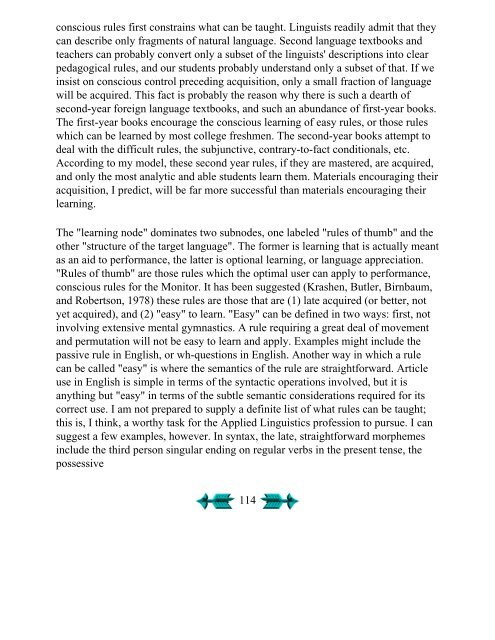Second Language Acquisition and Second ... - Stephen Krashen
Second Language Acquisition and Second ... - Stephen Krashen
Second Language Acquisition and Second ... - Stephen Krashen
You also want an ePaper? Increase the reach of your titles
YUMPU automatically turns print PDFs into web optimized ePapers that Google loves.
conscious rules first constrains what can be taught. Linguists readily admit that they<br />
can describe only fragments of natural language. <strong>Second</strong> language textbooks <strong>and</strong><br />
teachers can probably convert only a subset of the linguists' descriptions into clear<br />
pedagogical rules, <strong>and</strong> our students probably underst<strong>and</strong> only a subset of that. If we<br />
insist on conscious control preceding acquisition, only a small fraction of language<br />
will be acquired. This fact is probably the reason why there is such a dearth of<br />
second-year foreign language textbooks, <strong>and</strong> such an abundance of first-year books.<br />
The first-year books encourage the conscious learning of easy rules, or those rules<br />
which can be learned by most college freshmen. The second-year books attempt to<br />
deal with the difficult rules, the subjunctive, contrary-to-fact conditionals, etc.<br />
According to my model, these second year rules, if they are mastered, are acquired,<br />
<strong>and</strong> only the most analytic <strong>and</strong> able students learn them. Materials encouraging their<br />
acquisition, I predict, will be far more successful than materials encouraging their<br />
learning.<br />
The "learning node" dominates two subnodes, one labeled "rules of thumb" <strong>and</strong> the<br />
other "structure of the target language". The former is learning that is actually meant<br />
as an aid to performance, the latter is optional learning, or language appreciation.<br />
"Rules of thumb" are those rules which the optimal user can apply to performance,<br />
conscious rules for the Monitor. It has been suggested (<strong>Krashen</strong>, Butler, Birnbaum,<br />
<strong>and</strong> Robertson, 1978) these rules are those that are (1) late acquired (or better, not<br />
yet acquired), <strong>and</strong> (2) "easy" to learn. "Easy" can be defined in two ways: first, not<br />
involving extensive mental gymnastics. A rule requiring a great deal of movement<br />
<strong>and</strong> permutation will not be easy to learn <strong>and</strong> apply. Examples might include the<br />
passive rule in English, or wh-questions in English. Another way in which a rule<br />
can be called "easy" is where the semantics of the rule are straightforward. Article<br />
use in English is simple in terms of the syntactic operations involved, but it is<br />
anything but "easy" in terms of the subtle semantic considerations required for its<br />
correct use. I am not prepared to supply a definite list of what rules can be taught;<br />
this is, I think, a worthy task for the Applied Linguistics profession to pursue. I can<br />
suggest a few examples, however. In syntax, the late, straightforward morphemes<br />
include the third person singular ending on regular verbs in the present tense, the<br />
possessive<br />
114











